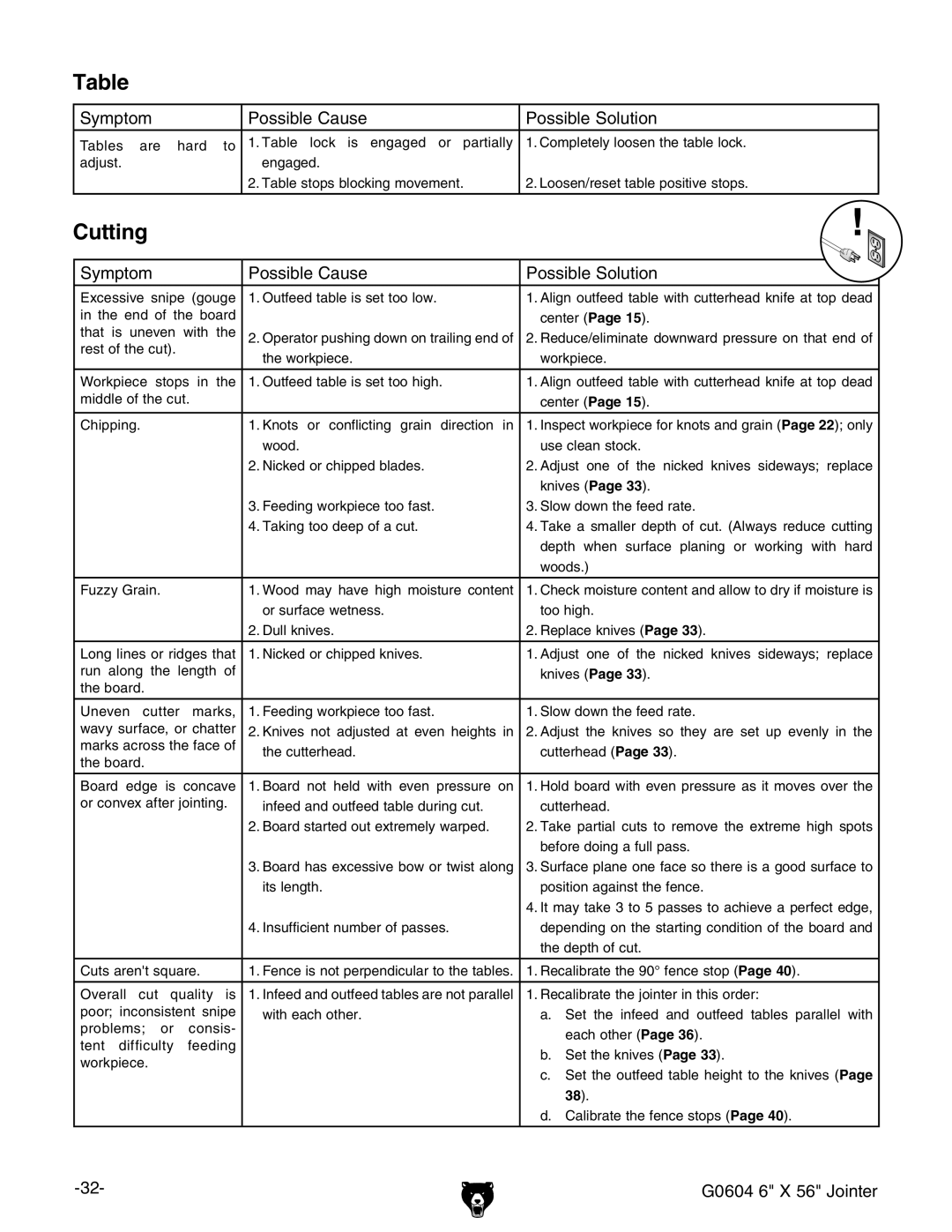
Table
Symptom |
| Possible Cause | Possible Solution |
|
|
|
|
Tables are hard | to | 1. Table lock is engaged or partially | 1. Completely loosen the table lock. |
adjust. |
| engaged. |
|
|
| 2. Table stops blocking movement. | 2. Loosen/reset table positive stops. |
|
|
|
|
Cutting
Symptom |
|
|
| Possible Cause | Possible Solution | ||
|
|
| |||||
Excessive snipe (gouge | 1. Outfeed table is set too low. | 1. Align outfeed table with cutterhead knife at top dead | |||||
in the end of the board |
| center (Page 15). | |||||
that is uneven with the | 2. Operator pushing down on trailing end of | 2. Reduce/eliminate downward pressure on that end of | |||||
rest of the cut). |
|
| the workpiece. | workpiece. | |||
|
|
|
|
|
| ||
|
|
|
| ||||
Workpiece stops in | the | 1. Outfeed table is set too high. | 1. Align outfeed table with cutterhead knife at top dead | ||||
middle of the cut. |
|
| center (Page 15). | ||||
|
|
|
|
|
| ||
Chipping. |
|
|
| 1. Knots or conflicting grain direction in | 1. Inspect workpiece for knots and grain (Page 22); only | ||
|
|
|
|
|
| wood. | use clean stock. |
|
|
|
|
|
| 2. Nicked or chipped blades. | 2. Adjust one of the nicked knives sideways; replace |
|
|
|
|
|
|
| knives (Page 33). |
|
|
|
|
|
| 3. Feeding workpiece too fast. | 3. Slow down the feed rate. |
|
|
|
|
|
| 4. Taking too deep of a cut. | 4. Take a smaller depth of cut. (Always reduce cutting |
|
|
|
|
|
|
| depth when surface planing or working with hard |
|
|
|
|
|
|
| woods.) |
|
|
|
|
|
| ||
Fuzzy Grain. |
|
|
| 1. Wood may have high moisture content | 1. Check moisture content and allow to dry if moisture is | ||
|
|
|
|
|
| or surface wetness. | too high. |
|
|
|
|
|
| 2. Dull knives. | 2. Replace knives (Page 33). |
|
|
| |||||
Long lines or ridges that | 1. Nicked or chipped knives. | 1. Adjust one of the nicked knives sideways; replace | |||||
run along the length of |
| knives (Page 33). | |||||
the board. |
|
|
|
|
| ||
Uneven | cutter | marks, | 1. Feeding workpiece too fast. | 1. Slow down the feed rate. | |||
wavy surface, or chatter | 2. Knives not adjusted at even heights in | 2. Adjust the knives so they are set up evenly in the | |||||
marks across the face of | the cutterhead. | cutterhead (Page 33). | |||||
the board. |
|
|
| ||||
|
|
|
|
| |||
|
|
|
|
|
| ||
Board | edge | is | concave | 1. Board not held with even pressure on | 1. Hold board with even pressure as it moves over the | ||
or convex after jointing. | infeed and outfeed table during cut. | cutterhead. | |||||
|
|
|
|
|
| 2. Board started out extremely warped. | 2. Take partial cuts to remove the extreme high spots |
|
|
|
|
|
|
| before doing a full pass. |
|
|
|
|
|
| 3. Board has excessive bow or twist along | 3. Surface plane one face so there is a good surface to |
|
|
|
|
|
| its length. | position against the fence. |
|
|
|
|
|
|
| 4. It may take 3 to 5 passes to achieve a perfect edge, |
|
|
|
|
|
| 4. Insufficient number of passes. | depending on the starting condition of the board and |
|
|
|
|
|
|
| the depth of cut. |
|
|
|
| ||||
Cuts aren't square. |
| 1. Fence is not perpendicular to the tables. | 1. Recalibrate the 90° fence stop (Page 40). | ||||
|
|
|
|
|
| ||
Overall | cut | quality | is | 1. Infeed and outfeed tables are not parallel | 1. Recalibrate the jointer in this order: | ||
poor; inconsistent snipe | with each other. | a. Set the infeed and outfeed tables parallel with | |||||
problems; | or | consis- |
| each other (Page 36). | |||
tent | difficulty | feeding |
| ||||
| b. Set the knives (Page 33). | ||||||
workpiece. |
|
|
|
| |||
|
|
|
| c. Set the outfeed table height to the knives (Page | |||
|
|
|
|
|
|
| |
|
|
|
|
|
|
| 38). |
|
|
|
|
|
|
| d. Calibrate the fence stops (Page 40). |
|
|
|
|
|
|
|
|
|
|
|
|
|
| G0604 6" X 56" Jointer | |
